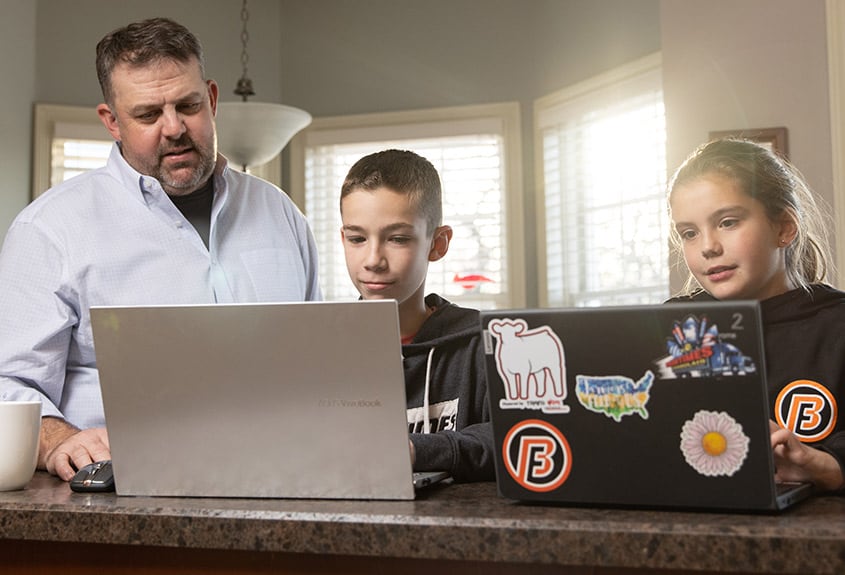Advocating for Better Rural Broadband
About 20 million rural Americans still don’t have access to high-speed internet.

Discover why advocating for better rural broadband is essential for #farmers and their families.
It’s easy to take access to a fast internet connection for granted — unless you live in a rural area of the country. There, lack of access has been an issue for years, and it affects rural residents in many ways.
click to tweet ![]()
Matt Barnard grows corn and soybeans near Gibson City, Illinois, and confronts the issue every day. When he’s able to gather information in the field, it’s hard to make use of it.
“We get home, and we try to upload that information onto whatever platform we’re using to manipulate it or share it, and it gets really, really tough,” he says. “You might start it at night and hope that it is done in the morning and that it didn’t time out.”
The lack of broadband in rural areas also affects other aspects of family life — a once-frustrating problem that in a pandemic environment limits essential access to education and professional commitments. For instance, Barnard’s kids go to school remotely, and his wife struggles to stay connected to Zoom so she can telecommute.
Barnard’s situation is familiar to Ariel Wiegard, Syngenta federal government relations lead, North America Business Sustainability. “Social distancing and quarantining are hard enough, but when you limit a family’s ability to conduct their business, go to school or visit their doctor, it really draws into sharp contrast the resources that urban or suburban households have access to versus their rural counterparts,” she says.When we look at productivity and the ability to use technologies like precision agriculture, one thing we run into constantly is the lack of broadband.
For anyone working in agriculture, the need is truly pressing. “When we look at productivity and the ability to use technologies like precision agriculture, one thing we run into constantly is the lack of broadband,” says Teddy Bekele, Land O’Lakes chief technology officer.
Digital Applications Improve Farm Efficiency
To maximize the benefits of the many digital applications available today, farmers need to be able to download millions of data points from their farms and then upload that data to the cloud or send it to their retailers or agronomists. That requires a broadband capability of about 100 megabytes per second. “So when growers, retailers and agronomists talk about needing better broadband, they don’t just need to get online — they need to at least hit that standard,” Wiegard says.
Because many can’t, when Syngenta develops tools like the software used in its whole-farm management program, AgriEdge®, the company adds extra features so the software has some functionality when users are offline. “But that limits what you can do when you’ve got equipment out in the field and you can’t communicate with it because it doesn’t have a signal, or you can’t access up-to-date satellite imagery that you could use for decision-making,” says Joe Ben Bogle, product manager for Syngenta Digital.
The current situation exacts a cost on all of American ag. “If we can foster a system where that data moves efficiently and can be analyzed by agronomists, or even by artificial intelligence, farmers can make highly precise in-season changes to their operations, and this has the potential to make the entire farming economy more profitable and more sustainable,” Wiegard says.
Ag Companies Help Farmers Seek Solutions
Creating cutting-edge digital tools like the software that’s part of AgriEdge is one way Syngenta helps drive demand for high-speed internet in rural communities, Wiegard says. “We are also partnering with equipment manufacturers and other food and ag companies to help create software that farmers want and need.”
Syngenta was also one of the first members of the new American Connection Project, a broadband coalition created by Land O’Lakes. More than 100 partners strong, the group advocates for better broadband infrastructure and funding, as well as improved coordination among the federal agencies that are addressing the problem.
That’s important because at the federal level, about 60 federal broadband programs with billions of dollars in broadband grants, loans and other resources exist, Wiegard says. The programs span 14 federal agencies, which include the Federal Communications Commission; the departments of Agriculture, Education, Interior and Transportation; and the Small Business Association.
“Just like in the 1930s when there were investments made to make sure that every house had electricity, the same thing needs to happen because broadband has become a must-have,” Bekele says. “Without that push, it won’t happen naturally — the economics don’t make a lot of sense for the broadband providers. This is why incentives and programs need to be put in place.”
It’s estimated that a huge public investment — somewhere between $80 billion and $150 billion — is needed to connect every single home in our country to broadband. To make that kind of investment, policymakers need to feel the importance of the issue. “One of the best things Thrive readers can do is contact their elected representatives in Washington, D.C., and tell them that they urgently need better internet and why,” Wiegard says. “The government is working on solving this problem, but we need to keep the pressure on.”
Rural Hot Spots Help Bridge the Technology Gap
To help rural residents today, Land O’Lakes has created nationwide locations where anyone can access guest Wi-Fi. “It’s not as convenient as having it in your own home, but at least it’s something near your community,” Bekele says. Today, there are more than 2,300 locations across 48 states where people can drive up and get online. Anyone can find their closest Wi-Fi hot spot at www.americanconnection.io.

